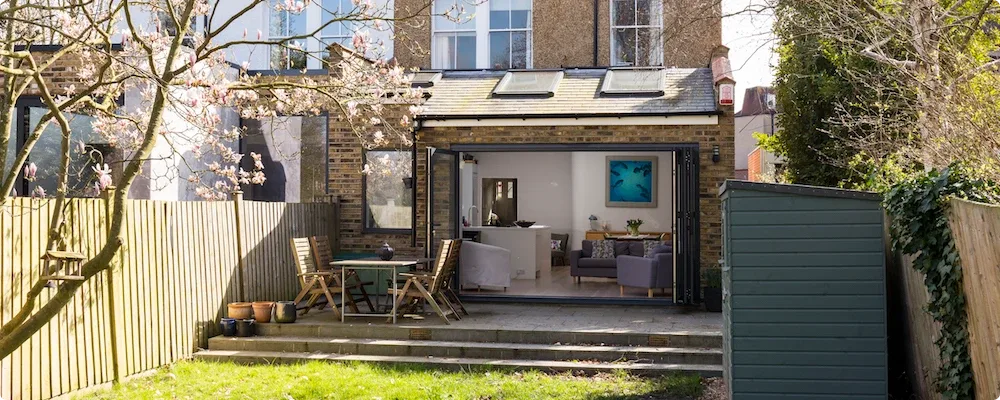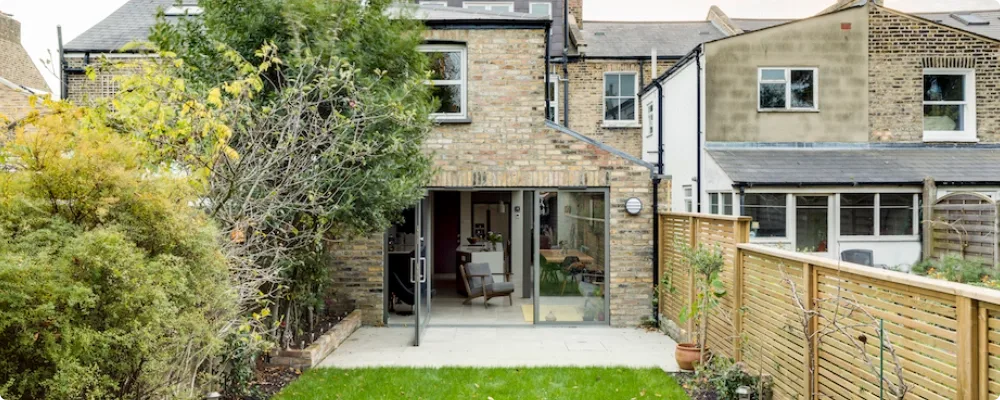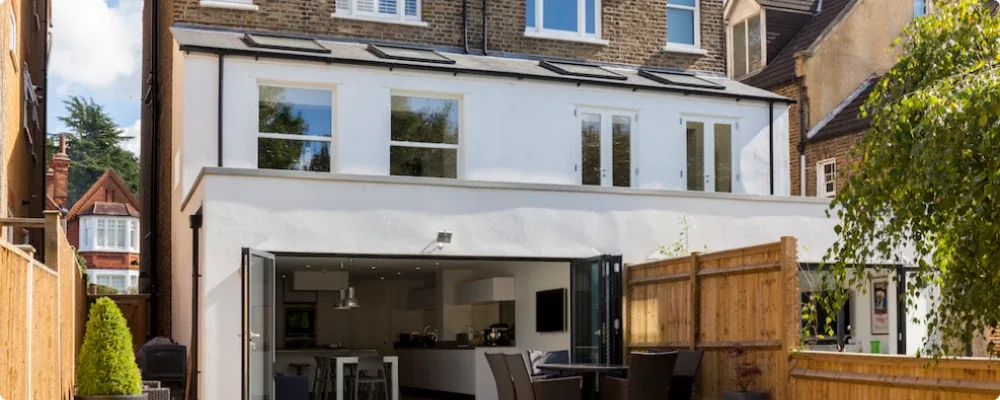When it comes to making space at home, you can’t beat an extension. The space they create is regularly used for additional bedrooms, ensuite bathrooms, larger kitchens, open-plan living spaces, home cinemas and gyms - whatever you are looking to achieve.
But what you do with the added space will depend on your first decision: what kind of extension you build. There are different types, built around different parts of the house, varying in price and feasibility, so how do you pick one?
So which projects are there to choose from?
Ground floor rear extension

Ground floor rear extensions are one of the most common extension types. They extend out of the back of the property into garden space. They are often finished with glass doors to increase natural light and accessibility to the garden.
Pros:
- High feasibility (may fall within permitted development rights)
- Typically one of the cheapest extension types
- Can open up accessibility to the garden
Cons:
Common uses:
- Kitchen and dining room extensions
- Living room extensions
- Open-plan living spaces
London estimate: £45,000 - £98,000
Outside London estimate: £37,000 - £80,000
Check out this example of a ground floor rear extension!
Ground floor side extension

Ground floor side extensions are built to the side of a property, which requires there to be enough free space. This usually restricts them to detached or end of terrace properties.
Pros:
- Typically one of the cheapest extension types
- Doesn’t use up garden space
- May fall within permitted development rights
Cons:
- Requires space to the side of the property
Common uses:
- Kitchen and dining room extensions
- Living room extensions
- Open-plan living spaces
London estimate: £45,000 - £98,000
Outside London estimate: £37,000 - £80,000
Check out this example of a traditional side extension!
Ground floor side return extension

A ground floor side return extension (sometimes known as a side infill) is a specific type of side extension which fills into an alleyway, squaring off an L-shaped property. Side returns are often applied to Victorian terraced properties as they typically feature this side alley.
Pros:
- Uses otherwise wasted alley space
- Doesn’t use up garden space
- Popular and therefore feasible
- Glazing finish can increase natural light
- May fall within permitted development rights
Cons:
- Shared party walls could be affected which can complicate the planning process
Common uses:
- Kitchen and dining room extensions
- Living room extensions
- Open-plan living spaces
London estimate: £52,000 - £98,000
Outside London estimate: £44,000 - £80,000
Check out this example of a side return extension!
Ground floor wraparound extension

Ground floor wraparound extensions combine a side or side return extension with a rear extension to create a huge L-shaped addition to the side and rear of a property. They allow for the introduction of premium features, such as doors, glazing and skylights.
Pros:
- Loads of space created
- Larger space allows for more desirable features, like a kitchen island
- Glass features can introduce more natural light
Cons:
- The large space created increases the project cost
- Uses up some garden space
Common uses:
- Kitchen and dining room extensions
- Living room extensions
- Open-plan living spaces
London estimate: £52,000 - £98,000
Outside London estimate: £44,000 - £80,000
Check out this example of a wraparound extension!
Two-storey extension

If a single-storey side or rear extension isn’t enough for you, you can always make them two storeys high! These are great for a dramatic home transformation, if you have the space and budget to spare.
Pros:
- Loads of space created across two storeys
- Introduces more space to the first floor which can be hard to do
Cons:
- The large space created increases the project cost
- Complexity and size of the extension may impact on feasibility
Common uses:
- Kitchen and dining room extensions
- Bedroom extensions
- Additional bathrooms
London estimate: £78,000 - £146,000
Outside London estimate: £65,000 - £120,000
Check out this example of a two-storey extension!
Basement extension - main house

A basement extension can mean building a new basement below the house or extending an existing one. A main house basement extension adds space directly below the main section of the property.
Pros:
- Digging down can be a great choice for areas with high land values, like London
- Underground space is naturally private and soundproof
Cons:
- Very complex project which increases cost and impacts on feasibility
- Typically little or no natural light in spaces created
Common uses:
- Guest bedroom
- Games room
- Lounge or home cinema
London estimate: £150,000 - £260,000 (50 sqm)
Outside London estimate: £124,000 - £215,000 (50 sqm)
Basement extension - whole house

A whole house basement extension adds an entire additional floor below the ground floor of the property. This is a dramatic change and creates lots of space, but the challenges of this project can affect price and feasibility.
Pros:
- Digging down can be a great choice for areas with high land values, like London
- Underground space is naturally private and soundproof
- Lots of space created
Cons:
- Very complex project which increases cost and impacts on feasibility
- Typically little or no natural light in spaces created
Common uses:
- Additional bedrooms and bathrooms
- Bars, spas and home gyms
- Lounges and home cinemas
London estimate: £240,000 - £416,000 (80 sqm)
Outside London estimate: £198,000 - £343,000 (80 sqm)
First floor extension

If your ground floor extends to the back or side of your property, you may be able to extend your first floor over it. Among other things, the feasibility is affected by the ground floor structure. A structural engineer will decide if it is strong enough to build over, otherwise it may cost a lot of money to strengthen.
Pros:
- Does not use up any otherwise useable space
- Adds space to the first food which can be hard to do
Cons:
- Requires an existing ground floor projection
- Ground floor must be considered structurally sound to build over
Common uses:
- Additional bedrooms
- Ensuite bathrooms
- Bedroom and bathroom extensions
London estimate: £30,000 - £65,000
Outside London estimate: £25,000 - £54,000
Dormer loft extension

Dormer loft extensions project vertically from the slope of the existing roof, creating a box shape. They are typically installed with conventional windows, although balconies can be installed as well.
Pros:
- Increases headroom, an issue in many lofts
- Increases natural light
- One of the cheapest loft extension types
- Popular and therefore feasible
- May fall within your permitted development rights
Cons:
- Not always the most aesthetically pleasing
Common uses:
- Bedrooms and bathrooms
- Offices and studies
London estimate: £38,000 - £65,000 (25 sqm)
Outside London estimate: £31,000 - £54,000 (25 sqm)
Check out this example of a dormer loft extension!
Hip to gable loft extension

A hip to gable loft conversion straightens an inwardly slanted end roof to create a vertical wall. This small change can make a huge difference to the feel of the living space inside, but is typically limited to detached and end of terrace properties.
Pros:
- Transforms interior space
- Can be combined with dormer for a huge loft space
- Increasing in popularity
- Increases natural light
Cons:
- Not suitable for mid terrace homes
- Can look out of place compared to a neighbour's roof
- More expensive than a dormer loft extension
Common uses:
- Bedrooms and bathrooms
- Offices and studies
- Dens and snugs
London estimate: £38,000 - £65,000
Outside London estimate: £31,000 - £54,000
Mansard loft extension

A mansard loft extension is constructed by raising the party wall (the wall shared with your neighbours), and then building out the loft against this wall. The roof remains flat, while one outer wall slopes gently inwards. Mansards are typically found at the rear of the house, and although they are suitable for many property types, they are most popular in terraced houses.
Pros:
Cons:
- Almost always require planning permission
- May affect neighbour’s right to light
- Longer construction times
Common uses:
- Bedrooms and bathrooms
- Offices and studies
- Dens and snugs
London estimate: £42,000 - £70,000
Outside London estimate: £35,000 - £58,000
What will influence your decision?
You should consider these factors when choosing an extension:
Use
How are you going to use your space? If you want a bigger kitchen it’s no good looking up to the loft. Typically, an extension type will suit a certain use.
Feasibility
Will you get permission to build it? Whether building within your permitted development rights or submitting a planning application, there are certain rules your project must follow to be built legally.
Cost
What are you willing to spend? Extension costs vary from project to project, but some are naturally more expensive than others. Basement extensions, for example, cost more due to the complexities involved with digging down.
*The costs we have provided throughout do not include VAT at 20%, nor do they include key fit-out items, such as kitchens, glazing, landscaping and bathrooms. The cost will also be affected if you plan to refurbish existing rooms alongside your extension.
To calculate the extra cost or to get a tailored estimate for your project, we suggest speaking with a member of our team.
Does one of these projects sound right for you?
Book in a call with our experts and take the first step towards making your dream home a reality!
































